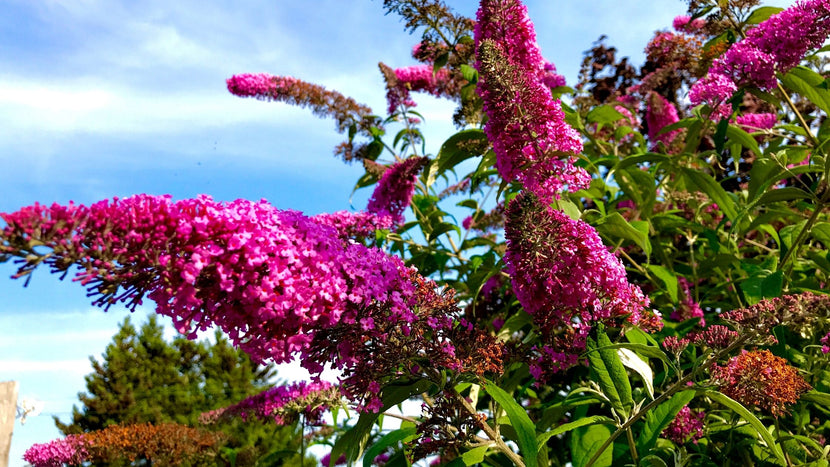How To Care For a Butterfly Bush
Plant Guide

Beyond being a powerhouse shrub for attracting local pollinators like butterflies, Buddleia, or better known as Butterfly Bushes, are loved for their easy-to-grow nature, unique flourishing panicles of blooms and their evergreen foliage!
If you are looking for a shrub to bring bold colors and interest to your landscape, the Butterfly bush is the yard plant for you! Coming in a wide range of colors, shapes and sizes, there's a buddleia bush for any and every yard design.
Ground Rules
Light
Butterfly Bushes grow best in conditions of full sun. The flamboyant flowering shrubs need at least 8 hours of bright light to thrive.
Water
Watering of the Butterfly Bush is a sensitive line between giving the plant just enough, but not too much. The roots of these shrubs are sensitive to rot, so this is where it is important that you do not give your Buddleia too much water. When in doubt, err on the side of caution and water less. These shrubs are drought tolerant and are better off going without water than with too much.
Soil
Butterfly Bushes are not too picky when it comes to their soil medium; however, it is important that you plant your shrub in a well draining soil medium.
Food
Fertilize your Butterfly Bush with a slow-release, organic fertilizer in the growing seasons of spring and summer for best results. We recommend Espoma Holly Tone!
Temperature
Suited for USDA Hardiness Zones 5-9, Butterfly Bushes grow best in moderate to warm climates. The hardy shrubs are known for handling the intense heat of summer and can handle temperatures up to 90 degrees!
Toxicity
Butterfly Bushes are not considered toxic to humans, nor are they toxic to animals.
Mulch
While many outdoor landscape plants benefit from light mulching around the root system, Butterfly Bushes are not one of these plants. Avoid mulching too much around the base of this plant because it can often lead to the plant retaining too much moisture and cause root rot. A light layer of mulch is the best way to go with these flowering shrubs.
Planting Process
- Unbox the Butterfly Bush and remove the packing. Water the plant and place it in a partially shaded location to acclimate to its new environment for a day or two.
- Select a location for your new plant(s) based on the light and soil requirements of the plant. Be sure to space out plants properly allowing room for growth.
- It is important that the hole is deep and wide enough to encompass the plant's full root system.
- Place the top of the root ball level with the surface of the hole. If the lilac is bareroot, the top layer of roots should be a few inches below the surface.
- Water your Butterfly Bush thoroughly.
- Backfill the rootball being careful not to leave anyvoids or pockets that expose the roots.
Beyond sunlight, water and soil, there are a few other steps that should be incorporated into your Butterfly Bush care regimen. A big one to mention is the need to prune your Butterfly Bush! Because Butterfly Bushes have been considered an invasive plant species, it is important that you do your part in ensuring it does not completely take over a space.
We recommend pruning your Buddleia in Spring after new growth emerges. Waiting till the Fall to prune your Butterfly Bush could leave your shrub more susceptible to damage in the winter.
When do Butterfly Bushes Bloom?
How do you deadhead a Butterfly Bush?
How do you propagate a Butterfly Bush?
Types of Butterfly Bushes
| Common Name | Botanical Name | Color |
|---|---|---|
| Black Knight Butterfly Bush | Buddleja davidii 'Black Knight' | Midnigh Violet |
| Flutterby Petite Blue Heaven Butterfly Bush | Buddleia 'Podaras#8' PP22069 | Vibrant Periwinkle |
| Flutterby Petite Titti Frutti Butterfly Bush | Buddleia 'Podaras#13' PP22177 |
Fuschia |
| Miss Molly Butterfly Bush | Buddleia davidii 'Miss Molly' |
Magenta |
| Lo & Behold 'Blue Chip Jr.' Butterfly Bush | Buddleia 'Blue Chip Jr.' PP26581, CBR5620 |
Lilac |
| Pugster Amethyst Butterfly Bush | Buddleia 'SMNBDL' PP30236 | Amethyst |
